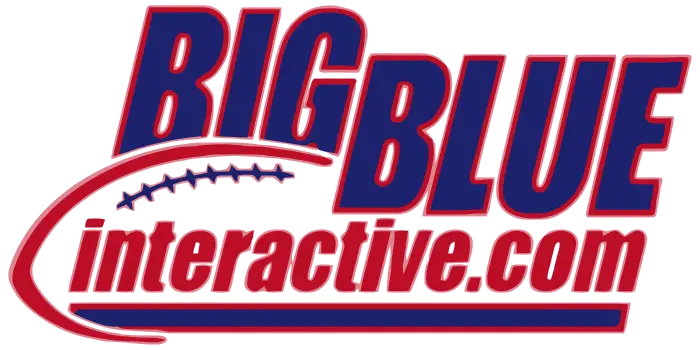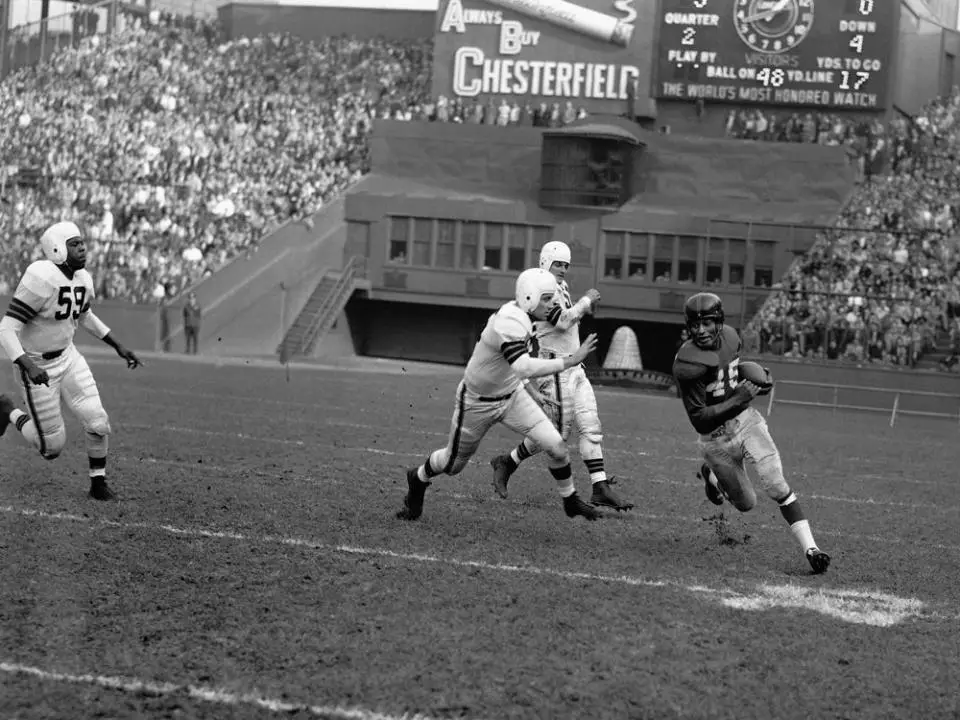Emlen Tunnell and Roosevelt Brown were the first and second African-American players of the New York Football Giants franchise, respectively. They arrived from obscurity – Tunnell as a free agent who walked in off of the street and asked for a job, and Brown as a 27th round draft pick chosen on a whim when his name happened to be noticed on a newspaper clipping. Despite their humble beginnings, both men became deeply rooted in the Giants family and remained fulltime members of the organization for the remainders of their lives.
Professional football was an integrated sport in the 1910s and continued to be so when the American Professional Football Association (APFA) formed in 1920. That circuit is known to have employed at least 13 African-American players between the years of 1920 through 1933, although none participated during the 1927 season. Most were members of the small-town teams like Akron, Rock Island, Hammond, Dayton and Canton. The one with the highest profile was Fritz Pollard, an extremely talented tailback who played with five teams from 1920 through 1925, including the APFA Champion Akron Pros in 1920 (which he also coached). Pollard was posthumously enshrined in the Pro Football Hall of Fame in 2005.
The only big-city team to have African-Americans on their roster for a significant length of time was the Chicago Cardinals who had three during their early years. They included the excellent tackle Duke Slater from 1926 through 1931 and halfback Joe Lillard who led the team in scoring in 1933. Lillard was released after that season, as was tackle Ray Kemp from the Pittsburgh Pirates, initiating a 12-year span where the NFL was an all-white league.
Although no official ban of African-American players has never been proven to have existed, it would be ludicrous to entertain the belief their exclusion was mere coincidence or happenstance. Some theorists believe, though it has never been proven, influential Washington Redskins owner George Preston Marshall, who entered the league in 1932 and became infamous two decades later for his all-white roster, was significant in convincing the other owners to eliminate black players from their rosters.
Possible motivation for an all-white league was marketing preference. Pro football at the time was desperately trying to climb the ladder of popularity in the 1920s and 1930s and tried to emulate baseball, which had been segregated since the 1880’s, in many ways organizationally. It would have been in line with the beliefs of the times that a league of white, college-educated players would be more appealing to prospective ticket buyers.
The league slowly and incrementally bolstered its fan base through the Great Depression and World War II years, but it likely had nothing to do with all-white rosters. Rather, it was accomplished by intelligent organization, the institution of an annual championship game and rules changes that improved the way the game was played on the field.
As a result of the ban, many talented black players, who professional football fans surely would have embraced and appreciated on a grander stage, languished in obscurity in semi-pro leagues. That is exactly what happened in 1946, one year before Jackie Robinson broke Major League Baseball’s color barrier. The impetus for integration was inspired by expansion, relocation and the threat from a rival league.
No Longer Separate, but Not Exactly Equal
Cleveland Rams owner Dan Reeves (no relation to the Dallas player of the 1960s who also coached the Broncos, Giants and Falcons in the 1980s and 1990s) had his eyes on the untapped market of the West Coast for a number of years, but his requests to move his franchise had been voted down. That all changed with the surplus of players who became available after the conclusion of World War II in 1945. Prospective owners who had unsuccessfully attempted join the NFL via expansion formed their own league, the All American Football Conference (AAFC), to begin play in 1946. The new league announced they would not only have a franchise located in Los Angeles, but also San Francisco. The NFL, which did not have a franchise further west than Green Bay, realized their tactical error and finally granted Reeves’ wish to move his team to avoid giving the AAFC exclusivity on the West Coast.
As Reeves negotiated to have the Rams play at the expansive Los Angeles Coliseum, he was told they would not be allowed to do so unless they had at least one black player on the team. Reeves responded by signing two former UCLA stars from the independent pro team Hollywood Bears, Kenny Washington on March 9, 1946 and Woody Strode shortly thereafter. Coincidentally, both players were college teammates of Jackie Robinson at UCLA.
Nearly simultaneously, Paul Brown was in Cleveland assembling the team that would dominate the AAFC and push the NFL into the future. Brown had known nothing but success everywhere he went, achieving legendary status as a high school coach at Massillon, OH, won a national title at Ohio State in 1942 and had his 1944 team at the Great Lakes Naval Station finish in the Top 20. Two of Brown’s hallmarks were having the best players he could find on his roster, and not tolerating racism. Despite there being no apparent color line in the AAFC, Brown signed the league’s first two African-Americans in August 1946, Marion Motley, who had played for Brown at Great Lakes, and Bill Willis, who played for Brown at Ohio State. Brown said years later, “I didn’t care about a man’s color or his ancestry, I just wanted to win football games with the best possible people.”
Despite these four men having integrated professional football a year ahead of Robinson and Major League Baseball, without receiving little fanfare, their perseverance was no less significant. Comparatively, the apparent indifferent public response was more indicative of pro football’s subordinate status at the time. Regardless, their contributions remain irrefutable as they opened the doors for many others to follow. They endured numerous hardships, including sometimes brutal physical and verbal abuse from opponents.
Motley said in their first few seasons officials turned a blind eye to late contact and dirty play, including elbows to the face (in an era where facemasks were still rare) and said he had several fingers broken by the opposition deliberately stepping on his hands. “Of course, the opposing players called us ‘nigger’ and all kinds of names like that. This went on for about two or three years until they found out that Willis and I were ballplayers.” Occasionally their teammates took policing action into their own hands and would call a “bootsie” play directed at an offending player where justice would be meted out at the bottom of the pile.
Off of the field, slights were commonplace. African-American players were often not welcome at the same hotels where their teams stayed, and regularly ate at separate restaurants. During the 1946 season, Brown left Motley and Willis behind on a road trip to Miami to play the Seahawks because he feared for his players’ safety. He assured them that Miami would not be in the league the next season, and true to his word, the franchise was rescinded and a new one arose in Baltimore.
Strode and Washington were both already past their primes when they joined the Rams and had brief stays in the NFL. Willis and Motley were magnificent performers, won multiple championships, and are both enshrined in the Pro Football Hall of Fame.
Hitching a Ride to the Big Time
The floodgates didn’t exactly open after 1946. The flow of African Americans into professional football was more like a trickle. The AAFC bolstered their African-American population at a slightly quicker rate than the NFL. Most notable of the 1947 additions were Cleveland’s end and punter Horace Gillom and the New York Yankees dynamic halfback and returner Buddy Young. Detroit was the second NFL team to employ African Americans when they signed halfback Mel Groomes on April 17, 1948 and end Bob Mann one week later.
Tunnell still had a year of college eligibility left in 1948 after missing his senior year at Iowa with an eye injury, but wanted to give pro ball a try. He hitchhiked from Garret Hill, PA to Manhattan. Tunnell recalled, “I was just about to forget it and go home when I got a ride from a West Indian guy in a banana truck who took me all the way to the Lincoln Tunnel.”
He made his way to the Giants offices at Columbus Circle and asked to speak with Coach Steve Owen. After Owen told Tunnell he’d never heard of him, General Manager Ray Walsh recognized Tunnell’s name from his time at Iowa, and brought him to meet owner Tim Mara. The owner was impressed enough with the player’s positive attitude and self-confidence to allow him a try out. It did not take long for Tunnell to prove himself worthy to Owen on the field and be offered a contract, officially making him the Football Giants first African-American player. The New York Times printed a three paragraphs documenting the Giants signing of the “Negro back” on July 25.
Tunnell and Tim Mara forged a bond that lasted until the owner’s passing in 1959. Tunnell said, “During that very first morning in the office, Mr. Mara gave me the feeling that I had found a friend in New York. He impressed me as a man who believed in his judgement. He stood on his own two feet and expected you to do the same. He was one of the finest men I’ve met. It wasn’t that he was a financial friend, although he certainly was that, but a personal friend.”
To survive physical practices designed to test the efficacy of newcomers, Tunnell befriended the Giants other African-American employee, trainer Charlie Porter. After being rousted by Owen from the cold tub after a brutal practice, Porter reinforced the coach’s fundamental beliefs while offering compassion to the bruised player who was questioning his confidence, “I let you come in here because I know he wouldn’t give permission to a rookie. Steve always says this game has to be played down in the dirt. He knows you’re physically tough enough to get down in the dirt. But in this league you have to be mentally tough, too, and some guys just aren’t.” Tunnell took Porter’s message to heart, and would ultimately set the NFL standard for most consecutive games started with 143 [since broken] before his playing days in New York were finished.
After learning the rigors of the trade at camp in Pearl River, New York, a battle-hardened Tunnell returned to New York and faced a host of off-field challenges. He was nearly arrested attempting to cash his first paycheck from the Giants when the teller and security guard had believed it was stolen. Lacking a driver’s license, Walsh had to come to the bank to vouch for Tunnell. He also experienced difficulty finding himself welcome at Manhattan Hotels, until he found the Henry Hudson, which Tunnell described as “a white hotel” and stayed there for eleven years. He also found himself late for a team meeting when a cab driver refused to bring him to the Polo Grounds. After being turned away at many restaurants, Tunnell alternately invited teammates to his favorite establishments in Harlem.
Tunnell had no such difficulty being welcomed in the locker room. His first and longest-lasting friendship was with another newcomer in 1948, quarterback Charlie Conerly. “I consider Charlie Conerly to be one of the best friends I have in the world, and I have reason to believe that he feels the same way about me. We hit it off right from the start. Charlie was a war veteran like myself…another thing we had in common was neither of us carried our race on our sleeve. We judged one another as football players and guys.”
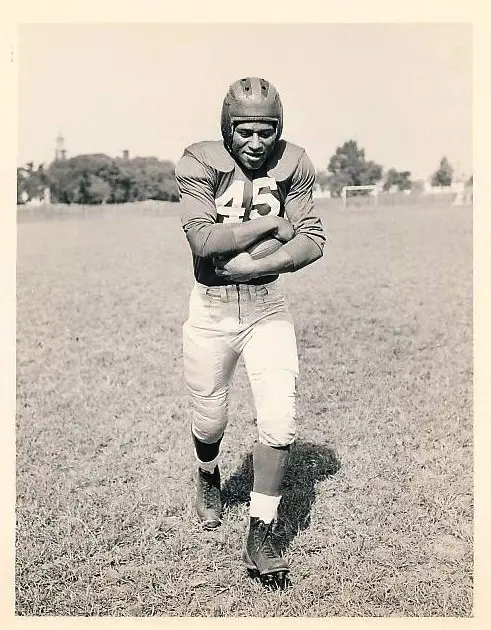
Emlen Tunnell, New York Giants (1948)
During his first regular season game, Tunnell was concerned about what the fans thought of him, and it caused him a deep conflict because his resolution conflicted with his coach’s orders. After taking several hard hits on punt returns, Owen told Tunnell to signal for a fair catch for the sake of his own safety. Tunnell said, “Like a good little rookie, I signaled for a fair catch on the next punt. As I ran off the field I heard some boos…There was another punt; another fair catch and a lot of boos. That tore it. When I got back to the bench, my neck was no longer brown. It was red. No player worth his salary reacts favorably to boos, and in my case there was something behind those boos that I didn’t like. I was sure that some of those people were booing because they thought to themselves, ‘The nigger is afraid to run with the ball.’ This was one of the few times in all my years in sports when I have been insubordinate to my coaches. ‘To hell with those fair catches,’ I snapped. ‘If you want somebody to make a fair catch, put another guy in there. I’m not going to have those people think I’m gutless.’ That moment of decision grooved me for the future. If I had been willing to go for the fair catch or if Steve had been unwilling to let me play it my way, I would not have been the player I turned out to be.”
Tunnell went on to set NFL single-season and franchise records for punt returns and punt return yards that lasted over a decade.
Tunnell struggled with more than punt returns his rookie season. He was unsure of his assignments, and accrued a large number of defensive holding penalties as he repeatedly was fooled in one-on-one coverage situations in pass defense and also never quite found a defined role on the team as he played sporadically on offense.
The turning point came on November 21st against the Packers in Milwaukee when Tunnell intercepted three passes (the first of four three-interception games of his career) and returned one 43 yards for his first touchdown as a professional. Tunnell said, “I was making the ping-pong transition from a guy who thought he was a great pass defense man to a guy who realized he didn’t know anything about pass defense to a guy who was learning a little about pass defense.” His renewed confidence was expressed with exuberant tackling. Tunnell knocked Green Bay back Jack Jacobs from the game.
Tunnell, who had also knocked out Philadelphia’s All-Pro halfback Steve Van Buren earlier in the season, relished the physicality of tackling as much as he enjoyed making a play with the ball in his hands: “I could make tackles until I’m 50. Your body may go, but your heart doesn’t.”
Influential Impact
The following offseason George Taliaferro, a multi-purpose back from Indiana, became the first African-American selected in the NFL draft. He passed up the opportunity to play with the Chicago Bears and instead chose to play with the Los Angeles Dons of the AAFC. At the conclusion of the 1949 season, six of the AAFC’s eight teams had at least one black player, while only three of ten NFL teams had one (the Rams, Lions and Giants.)
In 1949 Tunnell returned two of his then-franchise record 10 interceptions for touchdowns, as well as his first punt return for a score. The 10 interceptions is quite remarkable when considering the NFL played a 12-game season and teams only threw the ball approximately 41% of the time. [In 2014, NFL teams threw the ball nearly 57% of the time during a 16-game season.] Over the first 10 years of his career, Tunnell never registered fewer than six interceptions.
His most significant contribution to the Giants came in 1950 as a key cog in Owen’s Umbrella Defense, which was designed specifically to slow down the dynamic and explosive Cleveland offense. Tunnell said, “Steve Owen had a fine football mind, and he used it to concentrate upon the problems presented by the Browns…Otto Graham often sent out four potential receivers against the opposition’s three deep backs. When Cleveland’s great ends, Mac Speedie and Dante Lavelli, ran hook patterns that took them toward the middle of the secondary, the Browns halfbacks, Dub Jones and Rex Baumgartner or Ken Carpenter, would double flare, a maneuver that took them outside and deep. As an alternate to this, Speedie or Lavelli, or both, would run down and out to the sideline. The sideline pass was Graham’s bread-and-butter play.”
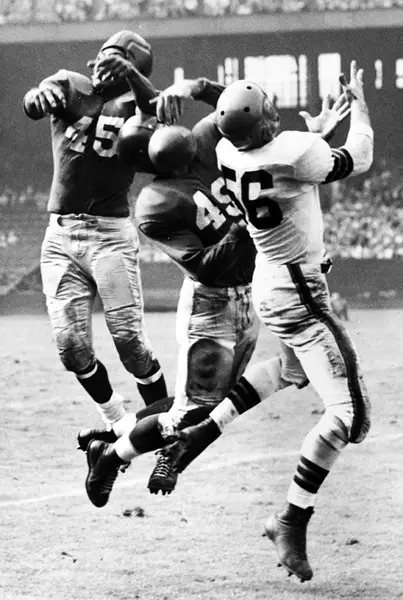
Emlen Tunnell (45), Tom Landry (49); New York Giants at Cleveland Browns (October 1, 1950)
Owen’s concept was to congest the traffic along the sidelines. After lining up in a six-man line, the ends would drop back into coverage, leaving the interior four to rush. The two safeties covered the deep middle while the two defensive halfbacks covered the area between the ends and safeties. The single linebacker keyed on fullback Marion Motley. Looking at the scheme on a blackboard, the defense resembled an opened umbrella.
The defense performed like an umbrella as well. In their first meeting, New York upset the Browns in Cleveland 6-0, the first shutout in the Browns’ history. Graham threw three interceptions and did not complete a single pass through the first half. It was the perfect answer for the quickly evolving T-Formation offense that had taken pro football by storm after World War II. The umbrella would be further refined by Tom Landry later in the decade as the 4-3 defense. The four defensive backs, operated intuitively with one another, passing off receivers and covering the field with an intricacy never before seen.
Tunnell said that 6-0 victory was so enjoyable that he never felt the urge to play on offense again. “I guess I got sold on defense when I teamed up with Tom Landry, Harman Rowe and Otto Schnellbacher in 1950. That was the best-tackling backfield I ever saw. Everyone knew what the other fellow was going to do and that’s what made it such fun. After that I never wanted to play offense again.”
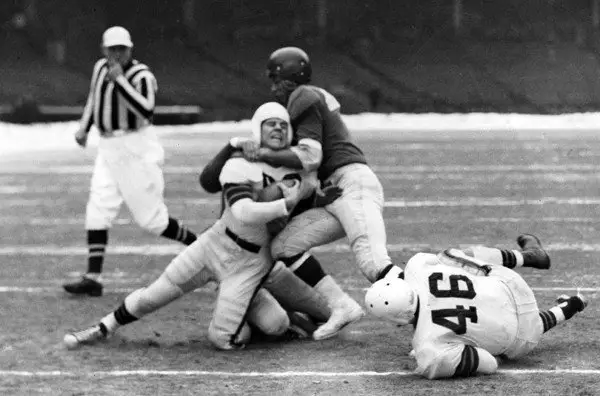
Emlen Tunnell, New York Giants; New York Giants at Cleveland Browns (December 17, 1950)
Tunnell reemphasized his passion for physical play when he reacquainted himself with Van Buren late in the season finale, which New York needed to win to maintain a tie in the standings with Cleveland. New York held a 9-7 lead on a snow-covered field when the Philadelphia back turned the corner and appeared headed for a long gain until Tunnell came across the field and stopped Van Buren dead in his tracks with a thunderous hit. The drive stalled and the Giants held on for the win. After the game Van Buren said, “I’ve been hit hard, but never that hard.”
Prior to the 1950 season, the Giants had made Robert “Stonewall” Jackson, a fullback from North Carolina A&T State, the first ever player from a historically black college selected in the draft. Jackson was a 29-yard old rookie, having put his college career on hold as he served in the Army during World War II, where he was awarded three Bronze Star Medals. His pro playing career only lasted two seasons, and he spent over 30 years coaching in college and is honored in the North Carolina Central
University Hall of Fame.
After the 1950 season, Detroit released its two African-American players, Bob Mann and Wally Triplett and did not have another black player on the team until 1958, a span that covered the entire coaching tenure of head coach Bubby Parker. After 1952, 10 of the NFL’s 12 teams had at least one black player, the exceptions being the Lions and Redskins. Washington owner Marshall infamously stated during the period, “We’ll start signing Negroes when the Harlem Globetrotters start signing whites.”
Tunnell set an NFL record in 1951 with 34 punt returns, three of which were run back for touchdowns. He also took place in a unique occurrence in pro football history on November 4, 1951. Against the New York Yanks at the Polo Grounds, Tunnell combined with Buddy Young, to record the first back-to-back kickoff return touchdowns in NFL history. Tunnell’s covered 100 yards for his and Young’s 90.
1952 was the season that Tunnell earned the moniker “Offense on Defense” as he was a big play waiting to happen when he got his hands on the ball. His seven interceptions for 149 yards, 30 punt returns for 411 yards and 15 kick returns for 364 yards totaled 924, more than the NFL’s leading rusher, African-American back “Deacon” Dan Towler of Los Angeles who gained 894 yards.
Quotas, Stacking and Skill Positions
African-American players were often relegated to positions that allegedly required less intelligence, which gave birth to the term “skill positions.” Black players found themselves grouped at such positions as halfback and safety on defense and backs and ends on offense. This tactic became known as “stacking”, which limited the number of African-American players who could make their respective team as they were competing against one another for the same roster spots. There were also implications that some teams may have had a quota in place for African-American players.
Hall of Fame receiver Raymond Berry, however, saw beyond common perception, and complemented Tunnell for more than his athleticism: “He had brains. He knew what was going on out there. He could cover, tackle, do it all. He was so knowledgeable about the position and the defensive schemes he played in.”
The position that proved to be the most difficult for black players to assume was quarterback. The first black quarterback since Pollard in the 1920’s was Willie Thrower in 1953. His experience was limited to two appearances, and eight pass attempts for the Chicago Bears. Thrower was released after the season and was not signed by any other teams. Tunnell reset the record for punt returns that same year with 38, and would stand until 1965.
Still, Tunnell is remembered by those closest to him for his physical style of play. Teammate Sam Huff recalled, “He was the hardest hitting guy in the league. He would hit people so hard they’d be afraid to catch a pass in front of him; catch a pass in front of Emlen Tunnell and usually you don’t finish the game.” Hall of Fame back Lenny Moore said Tunnell was the second-best tackler he faced after Dick “Night Train” Lane.
The Sleeper Pick
The Giants added their second African-American player, tackle Roosevelt Brown, in the 27th round of the 1953 draft. A member of the Giants staff saw his name mentioned on a black all-American team in the Pittsburgh Courier [a black newspaper] and during a moment of indecision when the Giants were on the clock, he suggested Brown as the team’s choice.
Brown was a unique physical specimen. He was a sculpted 245 pounds his rookie season with a 29-inch waist. In addition, he was one of the fastest players on the team, and would always be considered the fastest lineman in the NFL his entire career. Dedicated to physical conditioning, he was noted for routinely staying on the field after practices to run extra laps on his own.
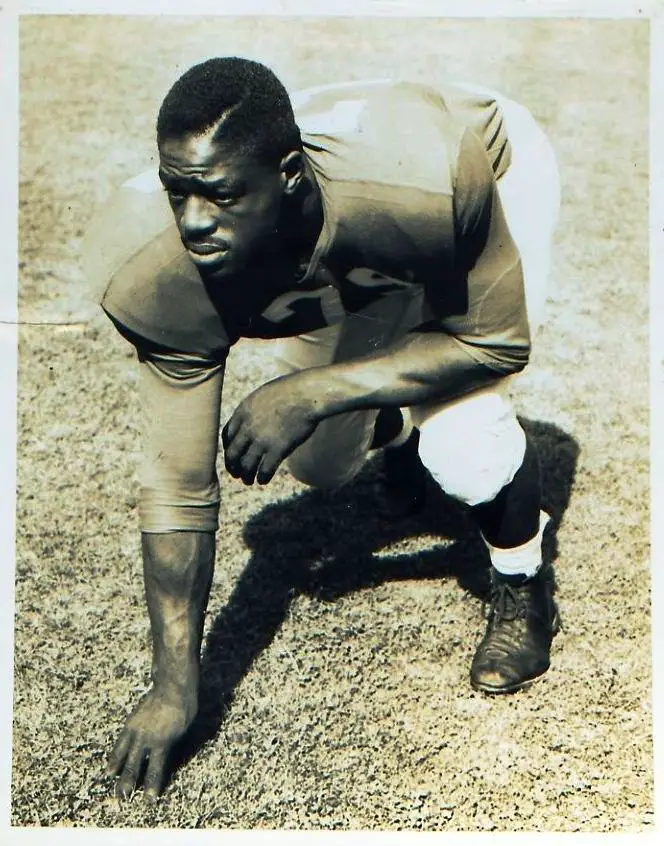
Roosevelt Brown. New York Giants (1953)
Like Tunnell before him, Brown’s mettle was tested right away in training camp. Coach Owen lined Brown up across from ferocious All-Pro defensive tackle Arnie Weinmeister in drills. Brown was beaten repeatedly and finished the day physically battered, but Owen was impressed with the young player’s resolve.
Brown ascended from the bottom of the depth chart and was New York’s starting left tackle on opening day in September as a rookie. His transition to New York was made easier by the now-established veteran Tunnell. Brown, who roomed with Tunnell in 1953, said, “Within two months, Emlen had introduced me to every cabby, maître d’hôtel, barber, teammate, cop or politician I needed to know in New York. There was no fuss to it. They were Emlen’s friends.”
While New York had a dismal season in 1953, Brown proved to be a bright spot and someone the new coaching staff could build around. Brown proved to be an instinctive pass blocker early on, exhibiting patience that belied his experience as he held his ground while defenders tried to maneuver around him. On running plays, Brown dominated the point-of-attack and pierced the front wall of the opposition’s defense creating running lanes. Beginning in 1954, offensive coach Vince Lombardi turned Brown into pro football’s first pulling tackle on his signature play: the power sweep.
Brown regularly logged the most minutes played for the Giants the first 10 years of his career. In the days of small rosters (teams carried 33 active players in 1953, expanded to 35 in 1957, 36 in 1959 and did not reach 40 until 1964), versatility and endurance were highly valued. Brown was a mainstay in New York’s goal-line and short-yardage defenses, and regularly lined up over the center in the middle guard position.
While being a generally quiet man who chose not to draw attention to himself, his former teammates were not at all reticent to describe his play and importance to the Giants. “As far as I’m concerned, Rosie was the best offensive tackle ever to play,” said Frank Gifford. “We knew the moment we saw him that this was one of the great physical specimens, eventually rounding out at about six-feet-five and 270 pounds. But nobody imagined his incredible athletic ability. Rosie was so fast he could have played running back and would have made a great tight end.
“Rosie and I teamed up on one of Lombardi’s most effective plays, the 48 Option. It was a quick pitch to me, and I either ran the ball around the left end or threw it, depending on what the defensive cornerback did…Rosie just loved to annihilate those little cornerbacks. There’d be nothing but grease spots left of them when he got up. In the huddle he’d practically froth when they called the 48 Option. It gave me my longest career run from scrimmage [79 yards, November 29, 1959 vs. Washington]. On that one, Rosie creamed the cornerback, got up to chase after me, and wiped out another defensive back nearly 40 yards downfield.”
There was no coincidence that in 1956 when Brown was named the NFL’s Lineman of the Year, Gifford was also voted the NFL’s MVP. “I wouldn’t be in the Hall of Fame if it weren’t for him,” said Gifford.
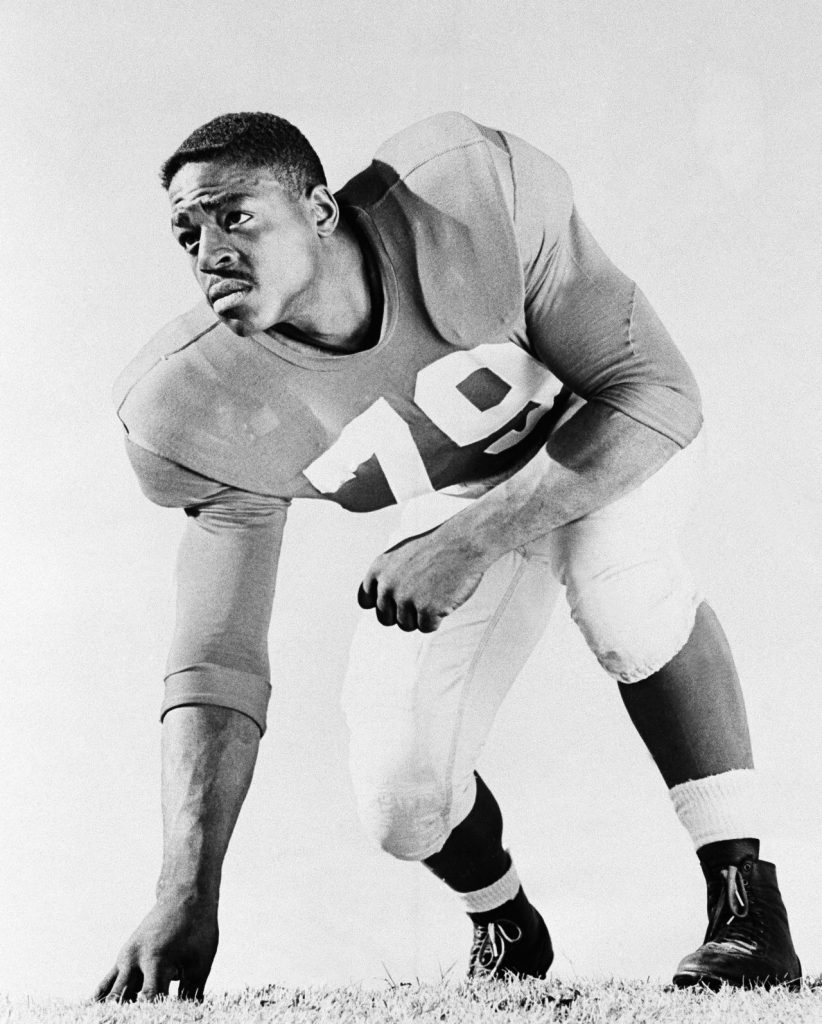
Roosevelt Brown, New York Giants (1956)
Sam Huff said, “Our MVP lineman had to be Roosevelt Brown. He was nothing but muscle, a bigger version of Jimmy Brown, and he was all heart. He was so valuable to our team he even played some defense. Rosie also played on all the special teams.”
Opponent, peer and Hall of Fame Baltimore guard Jim Parker said, “Rosie never did the same things twice. He was incredible. He was my favorite, my idol. Everything I learned I picked up from him. I wanted to be just like him.”
Refuting the perception that black players lacked intelligence, longtime New York coach Allie Sherman regarded Brown as being an “extra coach” on the field for his team. He said Brown often alerted teammates to changes in the opposition’s sets. And he also marveled at Browns’ athletic gifts. “Nobody could do the things he could do,” said Sherman. “He was so quick that on an end run, in the time it took a quarterback to lay the ball in the runner’s belly, he could slide all the way down the line in the direction of the play, get there before the ball carrier and join in the run block with the two guards at the point-of-attack.”
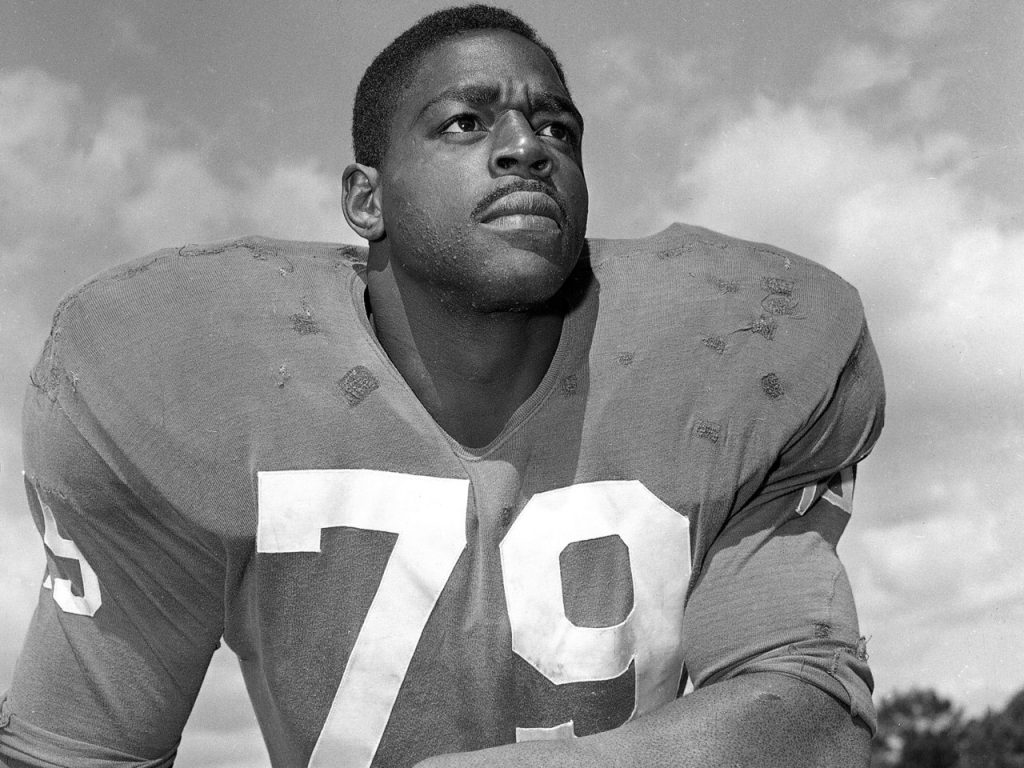
Roosevelt Brown, New York Giants (1958)
Brown received numerous accolades from his peers and football personnel, who voted him to nine Pro Bowls and named him All Pro six times over his career.
Progress
As more black players made their mark in professional football, more joined the ranks. In the 1953 and 1954 seasons, African-American Joe Perry of San Francisco became the first player with back-to-back 1,000 yard rushing seasons.
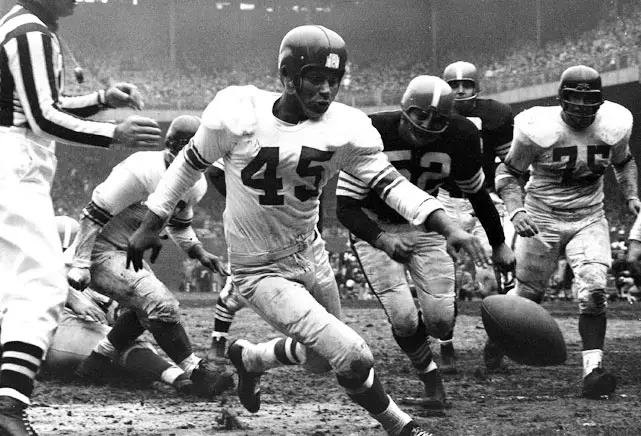
Emlen Tunnell (45), New York Giants (November 28, 1954)
In 1954, the Giants added end-kicker Haldo Norman and fullback Bobby Epps, which doubled the number of African-Americans on the team. Norman injured himself mowing his lawn shortly before training camp and only appeared in the preseason. Epps had a productive three-year tenure in New York and started 21 games over the 1954 and 1955 seasons.
Two cornerstones of the great Giant teams to come arrived in 1955, defensive tackle Roosevelt Grier and fullback Mel Triplett. Their transition was made easier by the men who preceded them. Giant captain Andy Robustelli reflected years later: “One of the reasons we never had problems was because of Em Tunnell. Emlen was good to all people. He was a hell of a decent person who meant a lot to young ballplayers.”
While the NFL’s African-American population gradually increased during the 1950’s and locker rooms appeared to be harmonious, there were still uncomfortable encounters on the field of play. Gifford recalled: “Perhaps because Rosie was so talented, some of the clowns we played against gave him a real racist initiation. He’d hear, ‘you black motherf—–,’ and a lot worse. When he’d come back to the huddle, I’d be as embarrassed as he was.”
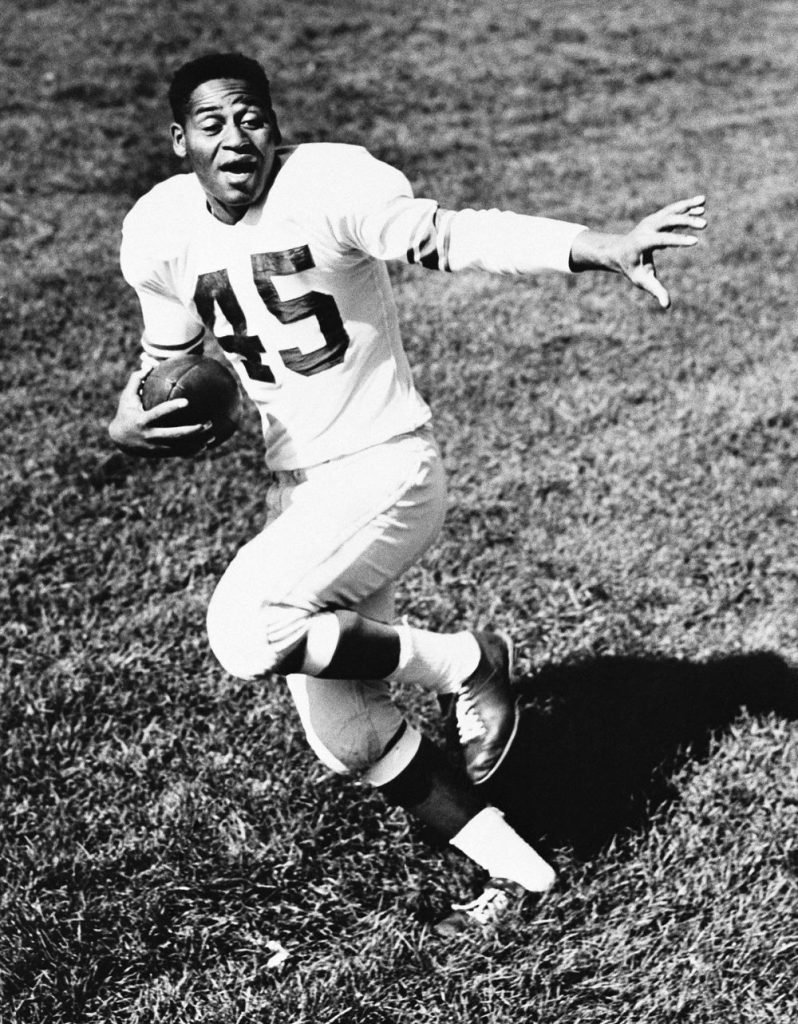
Emlen Tunnell, New York Giants (1955)
Tunnell was perceived as pleasant, friendly and easy going without a care in the world. But he often confided his worries and frustrations with his close friend Conerly. Conerly told Tunnell one evening in the early 1950’s, “Time will heal everything. Just like you came here to play. You were the first colored guy and since then there have been more and more. That’s how it will be in everything else.”
While the social pressures were tremendous, there also happened to be an unforeseen positive consequence – a little freedom from the coaches and bed checks while on the road. When the team stayed in white-only hotels, alternate arrangements were made for Tunnell, Brown and the other black players on the team. Brown said, “Wellington Mara always took care of it, and the people we stayed with were always nice people with nice homes, and we loved it. We didn’t have any curfew like the other guys, and we could do anything we wanted – drink beer and party – with no coaches checking up on us. Sometimes Charlie Conerly, Frank Gifford and Alex Webster would come over where we were staying, and once Frank said, ‘Hell, you guys got the best of two worlds.’ It actually upset me when the segregations arrangements ended, and we had to stay with the rest of the players.”
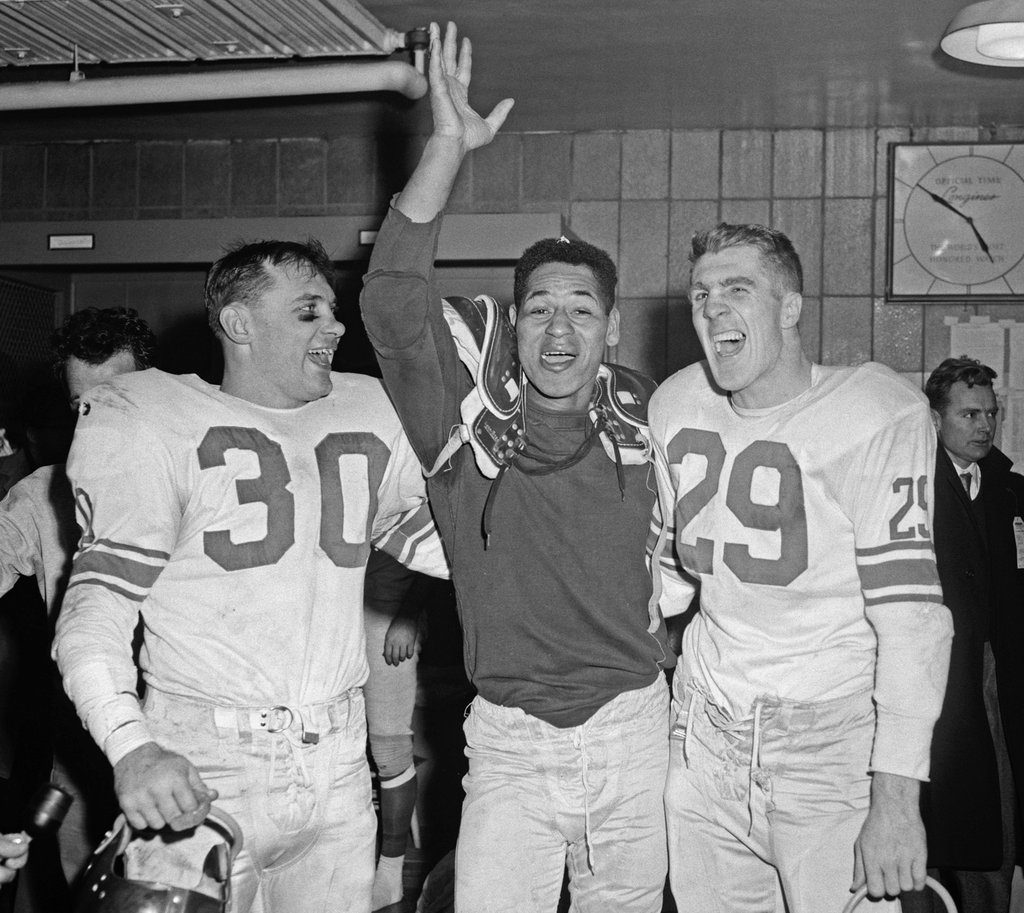
Bill Svoboda (30), Emlen Tunnell (middle), Alex Webster (29); (December 30, 1956)
By the decade’s end however, many players had had enough and stood up for change. Rosey Grier remembered an exhibition trip to Dallas with the Colts in 1959. “We black players knew what going to Dallas meant: the white players would stay in one hotel and we would be housed in another one that was presumably more suited to our race. It was always that way in the South. It was awkward, because we had to take a bus to the hotel where the white coaching staff and players were staying for meetings and the like. But, when it came time to eat, we had to get back in the bus and go someplace where it was okay for blacks to eat.
“But, in 1959 in Dallas, we had a change of heart. It may have been provoked by the promotional nature of the trip that called for all the players to attend a pre-game party downtown where we could be gazed at by local businessmen who might be interested in backing an NFL franchise for Dallas.”
Grier, Brown, Triplett and the black players from the Colts, including Lenny Moore, discussed boycotting the pre-game event as a form of protest. When Grier and the others refused to board the Giants bus to the pre-game party, Coach Jim Lee Howell became alarmed. Wellington Mara had overheard the discussion and intervened, “We didn’t know you felt like this, and I promise you in the future we won’t go anywhere we can’t stay together.” All the Giants attended the party, but the African-American players from Baltimore refrained. Although Grier questioned whether they had given in too easily at first, Mara proved true to his word and New York never again patronized a segregated establishment.
Breaking Barriers off the Field
Tunnell’s final game in a Giants uniform took place on December 28, 1958 against Baltimore in the “Greatest Game Ever Played.” Tunnell was believed to have slowed down with age. He had his return duties reduced and occasionally chafed with defensive coach Tom Landry, and was released after the season. He played three more years in Green Bay, and his final game was the 1961 NFL Championship Game against the Giants, where he intercepted a Y.A. Tittle pass during the Packers 37-0 victory.
Tunnell spent the 1962 season in the unusual capacity of serving as a freelance scout for both New York and Green Bay. The Giants were impressed with Tunnell’s insightful work and hired him as a full-time assistant coach in 1963, the first African-American to serve in such a capacity. Lowell Perry of the Steelers served as an assistant coach in 1957 after having his pelvis fractured and hip dislocated by Grier and Bill Svoboda of the Giants in 1956, then was a part time scout for Pittsburgh in 1958 before moving into private business.
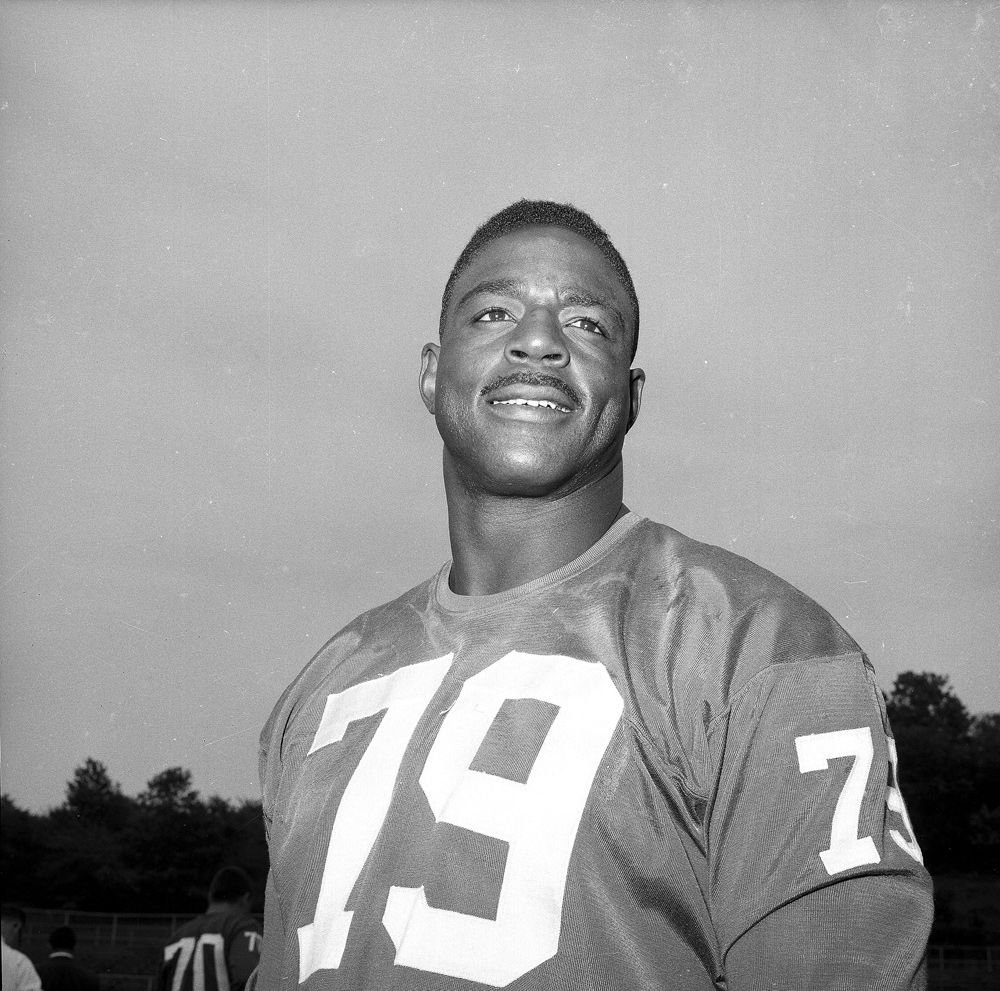
Roosevelt Brown, New York Giants (1962)
Brown was forced into retirement by a chronic phlebitis condition after the 1965 season and joined Tunnell on New York’s coaching staff in 1966. Both men cherished working with young players and reflected on how pro football had changed dramatically in the time since they had entered the league.
Tunnell said: “You knock people down, you stop people from scoring – there’s no difference. The only difference is that there are more players and there’s more money…I think the quality is different simply because there’s more teams…I think the desire is gone because I’ve had players say to me, ‘There are 26 teams, I’ll get a job.’ And it’s true…It doesn’t bother me, ‘cause it’s their money. There are a lot of guys making money who don’t put out and that bothers me more than anything. I don’t understand it, because when they go out to work they can’t make the same kind of money they’re making playing pro football. They don’t stay after practice. They don’t enjoy themselves. The Kyle Rotes, the Giffords, the Tunnells, the Rosie Browns, the Robustellis – they stayed out every day on their own time. I used to run up to 10 punts every day, 75-80 yards, up until I got too old. I did it because I enjoyed it.”
That love poured over into his coaching as well. Tunnell once reprimanded a player he had personally scouted and brought to the Giants, Carl “Spider” Lockhart, during a contract dispute. Tunnell told Lockhart playing for the Giants was a privilege, “You should be paying them. Sign that contract!”
Tunnell said of the changes since he became one of the first African-Americans to play professionally in 1948, “There are more black players now. They’re playing because they’re good enough to play, not because they’re black.”
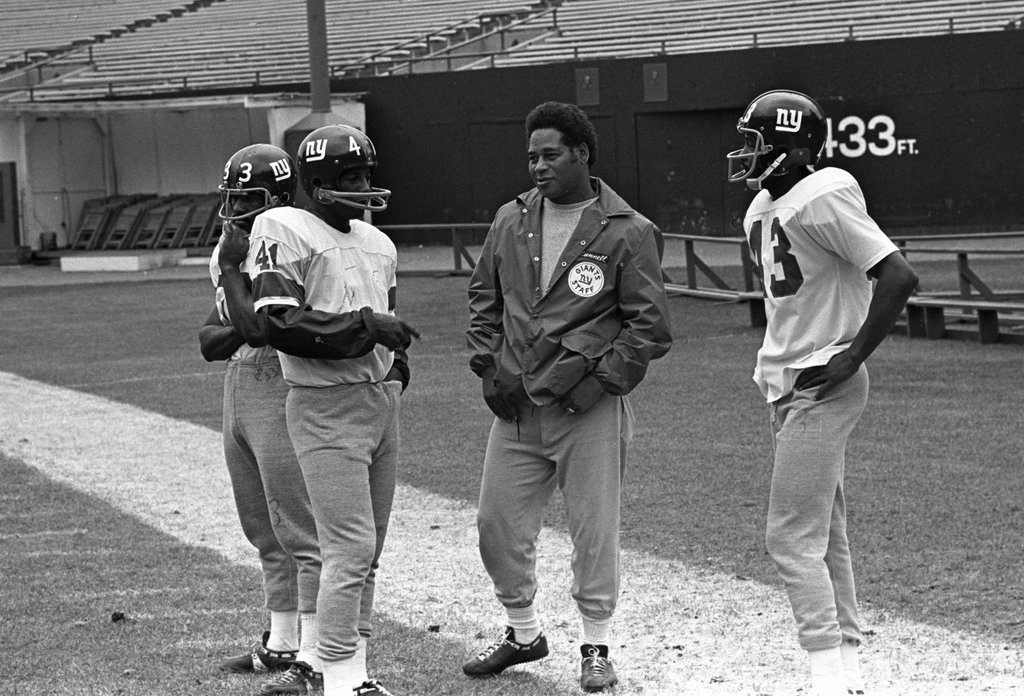
Joe Green (#33), Willie Williams (#41), Coach Emlen Tunnell, Carl “Spider” Lockhart (#43) at practice in 1971
While coaching the Giants group of defensive backs, known as “Emlen’s Gremlins”, Tunnell received pro football’s highest individual honor, enshrinement into the Hall of Fame in 1967. Tunnell is not only the first African-American member in Canton, but also the first player recognized as a defensive specialist from the two-platoon era (though his punt and kick return accomplishments were certainly considered.) During his brief acceptance speech, he thanked his coaches, the Maras and the driver of the banana truck who picked him up hitchhiking to the Giants offices.
During this time, Marlin Briscoe became the first African-American to assume the role of a regular starting quarterback for a pro football team. Briscoe started 11 games in 1968 for Denver of the AFL. He spent most of his career traveling and started 66 games for six different teams over the course of his nine-year career and played in the 1970 Pro Bowl.
Tunnell coached through 1973 and returned to scouting the following year. He served in that capacity until his death at training camp in 1975. John Mara said, “It’s fair to say that Emlen was the most beloved member of our organization, perhaps in its history.”
Brown coached through 1970 and returned to scouting in 1971, when he found a little-known defensive tackle named John Mendenhall who became a stalwart for the Giants defense through the decade. Brown was enshrined in the Pro Football Hall of Fame in 1975, and was the second player selected strictly on the merits of line-play (Parker was the first in 1973).
Brown remained with the Giants for the remainder of his days until 2004, an uninterrupted span of 51 years, and was ever-present around the offensive line drills during every training camp. Brown said in 1972, “I am very fortunate to have been with the Giant organization. I have never had to look over my shoulder…the organization, the coaches, they all had faith in me and I had faith in them. Even though we weren’t winning my first years with the Giants, there was a tradition of winning. The Maras were fine people and they know how to treat people right. The only thing for me was to do my best in return.”
Brown shared Tunnell’s view of the modern ballplayer, “Right now, I think we have too many average players. Too many ballplayers are thinking about Wall Street…A good player wants to win. For him this is it. Winning is the name of the game. I don’t think many of today’s players are as dedicated as they should be…[There is] no difference in the game itself. I think there is a difference in the money structure, which tends to lead a number of players the wrong way.”
Wellington Mara said Brown was the best lineman ever to perform for the team “Rosie was a great Giant. He was with this organization for more than 50 years as a player, coach and scout. He excelled in every area and he was always a gentleman.”
Both Brown and Tunnell combined to play in 17 pro bowls and were honored with 10 All-Pro selections during their careers in New York (Tunnell also participated in the 1959 Pro Bowl with Green Bay). Both men were selected by the Pro Football Hall of Fame as members of the All-1950’s Team. When Tunnell was named to the NFL’s 50th Anniversary team in 1969 it was a unique honor, as he was the only safety chosen. He was essentially declared to be the best safety in pro football’s history at the time. Brown was named to the NFL’s 75th Anniversary team in 1994, along with Forrest Gregg and Anthony Munoz at the tackle position.
At the time of the 1970 AFL-NFL merger, approximately 30% of all players were African-American. That number rose to 68% for the 2014 season. More than just numbers, the modern era of professional football displays the talents of African-American performers on the grandest of stages. Doug Williams became the first black quarterback to win a Super Bowl in 1987. Tony Dungy, who played on the 1978 Super Bowl champion Steelers, won a Super Bowl as a head coach with Indianapolis in 2006. The Giants have won two Super Bowl titles under the watch of general manager Jerry Reece.
Professional football advanced exponentially after the inclusion of African-Americans in 1946, and its popularity today reinforces the importance of the sacrifices endured by the pioneers who stepped forth during a time when they received no recognition. The game that is enjoyed by millions of fans today is better because of their contributions.
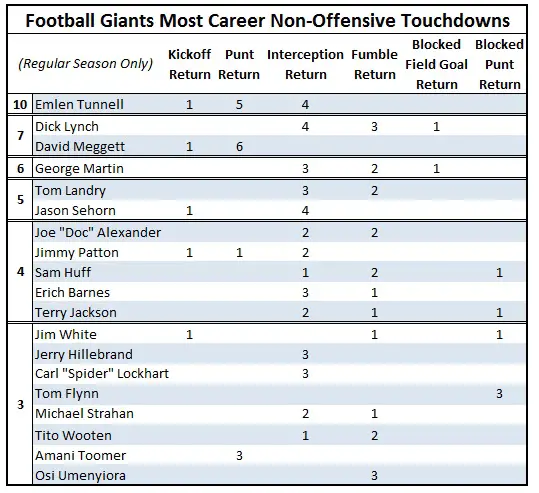
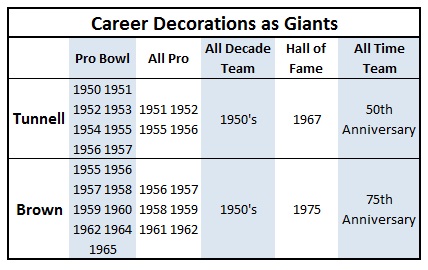
********************************************
SOURCES:
- New York Football Giants 1954 Press, Radio and Television Guide, Robert Daley, 1954, New York Football Giants, Inc.
- New York Football Giants 1957 Press, Radio and Television Guide, Robert Daley, 1957, New York Football Giants, Inc.
- The Giants of New York: The History Of Professional Football’s Most Fabulous Dynasty, Barry Gottehrer, 1963, Putnam
- Footsteps of a Giant, Emlen Tunnell with William Gleason, 1966, Doubleday & Company, Inc.
- The First 50 Seasons, Bob Oates Jr., 1969, Ridge Press
- New York Giants: Great Teams’ Great Years, Jim Terzian, 1973, Macmillan Publishing Co.
- There Were Giants In Those Days, Gerald Eskanazi, 1976, Prentice Hall Press
- Rosey: An Autobiography, Roosevelt Grier with Dennis Baker, 1986, Honor Books
- Tuff Stuff, Sam Huff, 1988, St. Martins Press
- The Whole Ten Yards, Frank Gifford with Harry Waters, 1993, Giff & Golda Productions
- Pigskin: The Early Years Of Pro Football, Robert W. Peterson, 1997, Oxford University Press
- The National Forgotten League, Dan Daly, 2012, University Of Nebraska Press
- 2015 New York Giants Information Guide, Michael Eisen, DeAndre Phillips, Corry Rush, 2015, New York Football Giants, Inc.
- 2015 Official NFL Record & Fact Book, Brenden Lee, Jacob Gellerman and Robert King, 2015, National Football League
- Historical New York Times searchable archive (via ProQuest)
